As a parent, the time you spend with your child—reading aloud, chatting, and interacting in countless ways—is pivotal in helping them develop and thrive as a reader, writer, and thinker. From teaching your child the alphabet to playing rhyming games, you instill crucial knowledge and skills through fun, playful time together. Best of all, it builds your relationship, too—and can even help you feel happier and more fulfilled.
That’s why each month we share a special list of featured reads and literacy activities. Expect fun seasonal reading recommendations, complemented with activity tutorials and free printables for an all-out story time experience with your little one.
Here are some topics to delve into with your child this month:
Picture Books for Father’s Day
Father’s Day is fast approaching! It’s a great moment to honor Dad—and all the special guys in your and your child’s life. This year, why not create a celebration of dads, uncles, and grandpas on your bookshelf?
The gift of a book is wonderful in and of itself, but the gift of time spent reading together is priceless. Check out this list of sweet picture books to read for Father’s Day and celebrate the men you care about. Bonus: Make a sweet DIY Father’s Day card with an acrostic poem or scroll down for a FREE printable Father’s Day card that your child can personalize.
Kids’ Books about Juneteeth
Juneteenth marks the day in 1865 that word of the Emancipation Proclamation finally reached enslaved Texans, two years and six months after President Abraham Lincoln issued it. On June 19, Union General Gordon Granger arrived in the state and announced the news, making Texas one of the last states to legally abolish slavery.
In 1980, Texas declared Juneteenth a statewide holiday and, thanks to the work of activists like Opal Lee, it recently became a federal holiday. To remember and celebrate the freedom the day commemorates, writer Courtney Runn compiled a list of inspiring and informative Juneteenth picture books to read with your children.
Picture Books for Pride Month
June is Pride month, a time to celebrate the LGBTQ+ community in all its uniqueness. It’s an opportunity for queer families to be seen and to share. It’s also a time to spark some valuable conversations with your children.
Early childhood educator Chrysta Naron has put together a list of some of her favorite joyful books with LGBTQ+ characters and stories for you to take a look at this month. As Chrysta says, be prepared for giggles, touching conversations, and tons of rainbow color!
Tips for Summertime Learning
If your child’s on summer vacation, it’s worth investing some time early on to cement the reading habit and ensure that reading books takes pride of place among free-time activities. Read our tips for summer reading and our article about proven ways to motivate kids to read for suggestions on building and reinforcing the love of reading.
We also have suggestions for fun summer activities that incorporate learning, to keep you and your little ones entertained all summer long.
If you’re hitting the road or visiting family this summer, you’ll also want to get our free printable road trip activity book below. And check out our posts on building reading and writing into family travel, educational road trip games, and using books to set the scene for great visits with relatives.
Story Time Activity: Ice Cream Reading
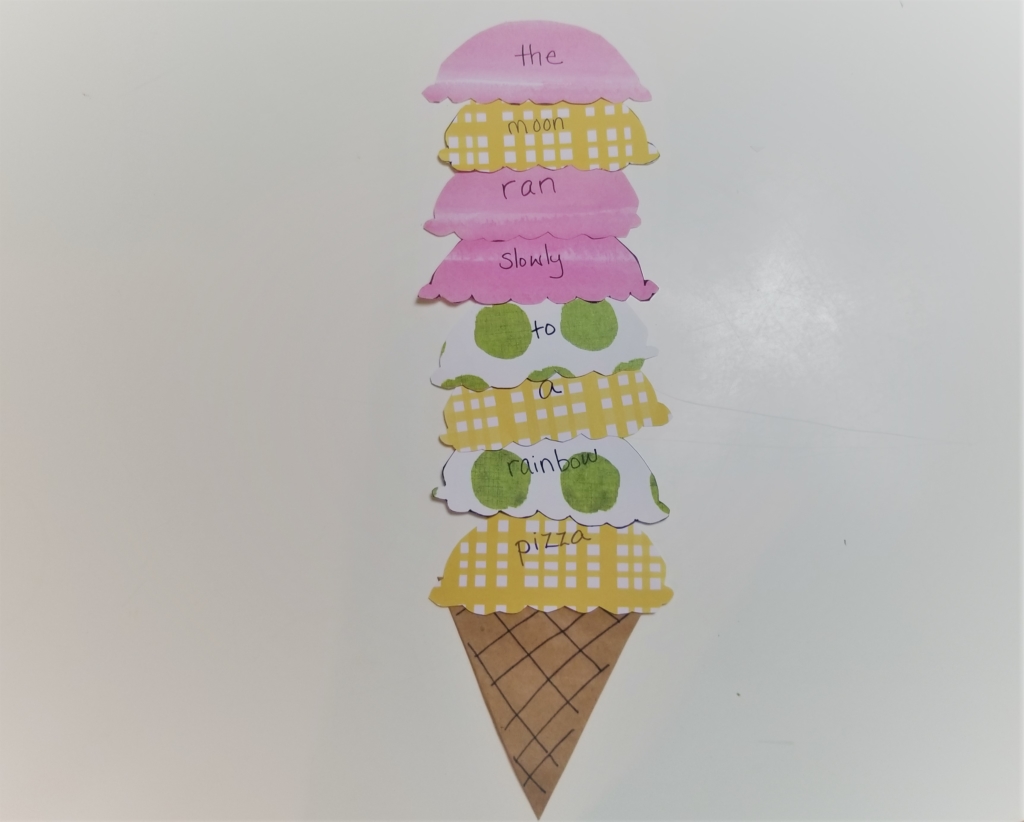
Sneak in some summertime learning as you make a summery craft in this cute DIY ice cream-themed reading game.
Enjoy this post? Please share it on social media.
New to MayaSmart.com?
Welcome! It’s lovely to have you here. I’m Maya, an author, literacy advocate, and mom. On this site, I publish articles, advice, book recommendations, and activities for busy parents. Through it all, my goal is to help parents like you feel equipped and confident to support your children in reading. Let’s start by understanding what you bring to the effort—your unique superpower.
Find your raise-a-reader superpower now.As a parent, the time you spend with your child—reading aloud, chatting, and interacting in countless ways—is pivotal in helping them develop and thrive as a reader, writer, and thinker. From teaching your child the alphabet to playing rhyming games, you instill crucial knowledge and skills through fun, playful time together. Best of all, it builds your relationship, too—and can even help you feel happier and more fulfilled.
That’s why each month we share a special list of featured reads and literacy activities. Expect fun seasonal reading recommendations, complemented with activity tutorials and free printables for an all-out story time experience with your little one.
Here are some topics to delve into with your child this month:
Picture Books for Mother’s Day
OK, moms, dads, grandparents, and readers everywhere! You know this is an important day to celebrate all the hard-working mamas and mama-types out there. And naturally sharing or gifting a picture book is our chosen way to do it.
Early childhood educator Chrysta Naron has curated a selection of darling picture books for Mother’s Day, plus a story time activity to go with them, in which you’ll make a lovely DIY Mother’s Day gift. Then extend the celebrations and the learning with an unforgettable Mother’s Day brunch, complete with a sweet keepsake menu handwritten by your child—see our Mother’s Day brunch activity post for tips and scroll down on this page for a free menu template printable!
Basketball Picture Books
Basketball is close to my family’s heart, and we understand how much this beloved game inspires young people all over. With the NBA Finals upon us, plenty of kids are feeling the basketball love right about now. Take advantage of this inspiration to do some themed reading with your child.
Austin writer Courtney Runn shares 12 inspiring picture books about basketball that will enthrall the little ballers in your life, all while imparting important lessons about everything from racism and resilience to perseverance and teamwork.
Kids’ Books about Senior Citizens
May is Older Americans Month, and that’s a great reason to celebrate grandparents or other senior citizens in your child’s life. It also offers an opening to delve into the topic of aging with your kids—and help them develop understanding, respect, and compassion for older neighbors, relatives, and friends.
Writer Karen Williams has curated a wonderful list of positive picture books about senior citizens and aging. Once you’re done reading, consider helping your child act on what they’ve read. Reach out to an elderly neighbor, make a date with a relative, or read Karen’s post on how to write letters to a senior citizen. The article includes links to organizations that will send your child’s notes to nursing homes or set them up with a senior pen pal.
Kids’ Books for Mental Health
May is also Mental Health Awareness Month, providing a valuable reminder to cultivate good mental health for ourselves and our children. Writer Andrea Hunt has delved into research indicating that reading aloud to our kids may have major benefits for parental wellbeing, that reading to kids can literally reduce their stress and pain, and that reading fiction can actually build emotional intelligence.
Check them out, as well as our roundups of picture books that foster body positivity and self-love, and picture books that build empathy.
Story Time Activity: Mother’s Day Love Jar
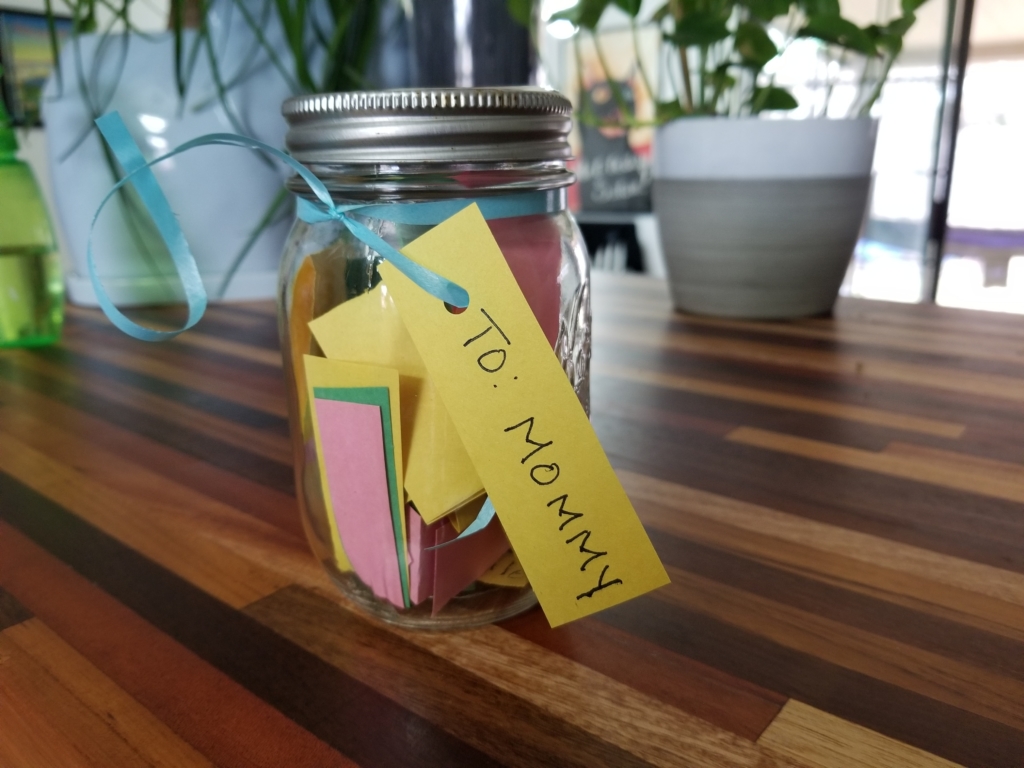
Learn how to help your child make a sweet and personal Mother’s Day gift in our Mother’s Day Love Jar tutorial & story time activity.
New to MayaSmart.com?
Welcome! It’s lovely to have you here. I’m Maya, an author, literacy advocate, and mom. On this site, I publish articles, advice, book recommendations, and activities for busy parents. Through it all, my goal is to help parents like you feel equipped and confident to support your children in reading. Let’s start by understanding what you bring to the effort—your unique superpower.
Find your raise-a-reader superpower now.As a parent, the time you spend with your child—reading aloud, chatting, and interacting in countless ways—is pivotal in helping them develop and thrive as a reader, writer, and thinker. From teaching your child the alphabet to playing rhyming games, you instill crucial knowledge and skills through fun, playful time together. Best of all, it builds your relationship, too—and can even help you feel happier and more fulfilled.
That’s why each month we share a special list of featured reads and literacy activities. Expect fun seasonal reading recommendations, complemented with activity tutorials and free printables for an all-out story time experience with your little one.
Here are some topics to delve into with your child this month:
Picture Books for Earth Day
Whatever else unites or divides us, our planet is truly everyone’s business. And on April 22, Earth Day provides a powerful opportunity to remember that, as well as to pass on a message of stewardship to the next generation.
From fostering environmentalism to inculcating habits of physical activity and mindfulness, Earth Day opens the door to a plethora of valuable lessons. And you can introduce and reinforce them all with a few choice reads. Find recommendations for awesome picture books to read on Earth Day, plus fun activities, in our free DIY Earth-shaped bookmark printable post, our article on Earth Day activities, and our article about easy ways to teach kids to care for the planet.
Kids’ Books about Easter and Passover
The world’s major monotheistic religions all have important holidays this spring. It’s a great time to share some picture books to celebrate your family’s traditions and/or to learn about other cultures. Last month, we shared Ramadan picture books.
For April, check out our list of Passover picture books, and your local library should have plenty of great titles featured for Easter and Passover.
You can also find a bunch of sweet Easter-themed literacy activities & crafts on the site:
- Follow a super-easy Read with Me Recipe for “Easter Egg Bread”
- Make an adorable Easter Bunny puppet & reading buddy
- Upcycle plastic Easter eggs into maracas & use them to support literacy
- Craft DIY storytelling dice for a sweet Easter basket gift or activity
- Put on a sight-word Easter egg hunt for your emerging reader
Books to Welcome Spring
Did you know that being in nature can help kids learn better, may combat ADHD as effectively as medication, and can soothe stress? So welcome the springtime and inspire your little nature explorer by reading about all the growth and new life happening at this time of year—and then go out and see it for yourself.
Try this sweet bird-watching activity for preschoolers (and don’t miss the great picture book recommendations at the end). You’ll also want to take a look at our list of picture books about gardens and gardening to teach your child about nature and where our food comes from. Then consider starting your own garden together, even if it’s just a single tomato plant on the windowsill!
Story Time Activity: Honor Earth Day
Taking your story time with your child and transforming it into a story time activity is a powerful way to build engagement, literacy, and comprehension. It’s also an important means of driving home a book’s message. Click here to read about three simple ways to create a sweet Earth Day story time activity, from taking a nature walk story time to helping your child create recycled art.
We’ll be back next month! Meanwhile, go ahead and browse around the site for more tips and tutorials. We’re so happy to have you here!
Enjoy this post? Please share it on social media.
New to MayaSmart.com?
Welcome! It’s lovely to have you here. I’m Maya, an author, literacy advocate, and mom. On this site, I publish articles, advice, book recommendations, and activities for busy parents. Through it all, my goal is to help parents like you feel equipped and confident to support your children in reading. Let’s start by understanding what you bring to the effort—your unique superpower.
Find your raise-a-reader superpower now.Welcome to the April edition of our monthly what to read to kids column! Keeping new books in the mix keeps family reading time fresh for your child (and you), as well as introducing them to new subjects and vocabulary.
That’s why we curate some of our best recommendations for diverse picture books around timely topics each month. We hope this inspires you to find some awesome new-to-you reads for your child at your local library or independent bookstore.
Plus, the last Saturday in April is Independent Bookstore Day, so why not grab this list and show some love to your local bookshop? Go in person and share the joy of browsing with your child, or shop independent bookstores around the country online.
Here are some books to delve into with your child this month:
Picture Books for Earth Day
Whatever else unites or divides us, our planet is truly everyone’s business. And on April 22, Earth Day provides a powerful opportunity to remember that, as well as to pass on a message of stewardship to the next generation.
From fostering environmentalism and climate to inculcating habits of physical activity and mindfulness, Earth Day opens the door to a plethora of valuable lessons. And you can introduce and reinforce them all with a few choice reads. Find recommendations for awesome picture books to read on Earth Day, plus fun activities, in our free DIY Earth-shaped bookmark printable post, our article on Earth Day activities from nature walk story times to recycled art, and our article about easy ways to teach kids to care for the planet.
Kids’ Books about Easter, Passover, & Ramadan
The world’s major monotheistic religions all have important holidays this month. It’s a great time to share some picture books to celebrate your family’s traditions and/or to learn about other cultures.
Check out our lists of Ramadan picture books and Passover picture books to get you started, and your local library should have plenty of titles featured for all three holidays. We’ve also got a bunch of fun Easter literacy activities, including a super-easy Read with Me Recipe for “Easter Egg Bread,” as well as tutorials for literacy-supporting DIY Easter basket gifts.
Picture Books about Baseball
Plaaaaay ball! It’s baseball season… and that’s one more reason to pick up some new picture books.
Whether your child is obsessed with baseball or barely knows what it is, our recommended baseball picture books will engage them with fun and inspiring stories—plus life lessons about teamwork, discipline, perseverance, and resilience. What’s more, the sport’s past and present can spark important conversations about history, racism, progress, and values.
If your child is a player or a fan, so much the better—one of the best ways to engage children in reading is to share books about topics they’re interested in. When kids are excited to cheer on their favorite players or love to play sports themselves, books by and about athletes are ideal to capture their attention.
MayaSmart.com is your one-stop-shop for raising a reader. Check out our other kids’ book lists and articles. In addition to bringing books into your reading time that tackle timely topics or important subjects, be sure to follow their interests, as well. If your kid loves science or animals—read about those topics. Following their interests keeps them engaged and helps you build a responsive relationship with your child.
We’ll be back next month with our guide for what to read to your child in May. Meanwhile, go ahead and browse around the site for more tips and tutorials, or message Maya with your questions. We’re so happy to have you here!
What are you reading with your child this month?
It’s never too soon to start reading aloud to your baby, because the benefits to their development are monumental. In fact, books, particularly sturdy board books, make some of the best toys to enrich your child’s first year. In our article on how to choose the best baby books, we highlight the different types of books you’ll want to share with your infant, plus how each engages them and lays the foundation for their future literacy.
Below, we’ve compiled a list of 12 engaging baby books to read aloud—2 from each baby book category we recommend—that will help set your baby on the path to becoming a great reader.
Noise Books
Books that draw attention to the sounds that animals, vehicles, and other objects make are cute, naturally popular with babies, and excellent for building awareness of the sounds that make up spoken language.
Nursery Rhymes
Nursery rhymes, whether classics or modern, are also great for helping bring babies’ attention to the sounds of language. Little ones love the rhythmic, sing-song reading even before they fully understand the words being said, so these stories are excellent for promoting the type of interactive reading that’s so beneficial to babies. In addition to collections of classic nursery rhymes, try these modern volumes.
Character Names
While many baby books don’t name characters, reading a few that do can heighten your baby’s reading experience and attention. Even very little ones can begin to make the connection between stories on pages and real-world experiences.
Photography Books
Books that feature real photography are especially good for young infants who are just learning to connect pictures of objects and people with real objects and people.
Bold & High Contrast
While we now know that babies are able to see a whole range of colors from birth, high-contrast books are nevertheless visually stimulating and engaging, particularly for very young infants.
Face (and Mirror) Books
Babies are naturally drawn to faces and even face-like shapes, so books that feature faces are a must for any baby book collection.
Reading a variety of books to babies even before they turn one is a great way to set them on their way to becoming readers.
What are your favorite baby books? Let us know!
The Seder nights … tie me with the centuries before me.
Ludwig Frank
Every spring that approaches brings with it another Passover—another week to spend with family and friends marking this Jewish holiday that has existed for thousands of years. And what better way to help children learn and celebrate than with a good book? This roundup of Passover kids’ books will answer questions about the story of Moses and the Israelites, explore the importance of tradition, take readers on wonderful adventures, and teach children how to help with the family Seder.
Board Books about Passover
Picture Books about Passover
Passover Activity & Cook Books to Share with Kids
What are your favorite books about Passover?
Happy Earth Day! Our free color-your-own Earth bookmark is designed to help children celebrate our planet, and to encourage kids to read at the same time. The free printable consists of two copies of the bookmark, so your child can make one and gift one in celebration of Earth Day.
Just print it out and make your own adorable DIY bookmarks. Then check out our recommendations, below, for great Earth Day picture books to use them in!
For other ways to celebrate our environment, check out our posts on easy, free Earth Day activities for preschoolers and Earth Day story time activities. Then read about how being in nature could make kids smarter for inspiration and a reminder about why it’s so crucial to preserve natural spaces for future generations.
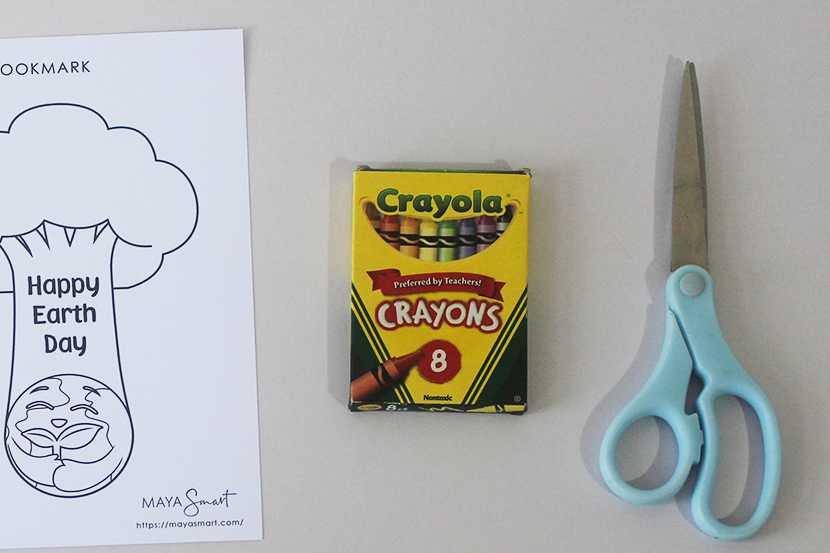
Materials
- Printer
- Cardstock paper
- Coloring materials
- Scissors
Then print it on a piece of cardstock paper, or if you don’t have cardstock, just print it on normal paper and then paste it onto thin cardboard that you’ll be able to cut easily (such as an empty cereal box). Then help your child cut out their DIY bookmarks and color them in! Or gift your bookmarks to someone else to color in themselves.
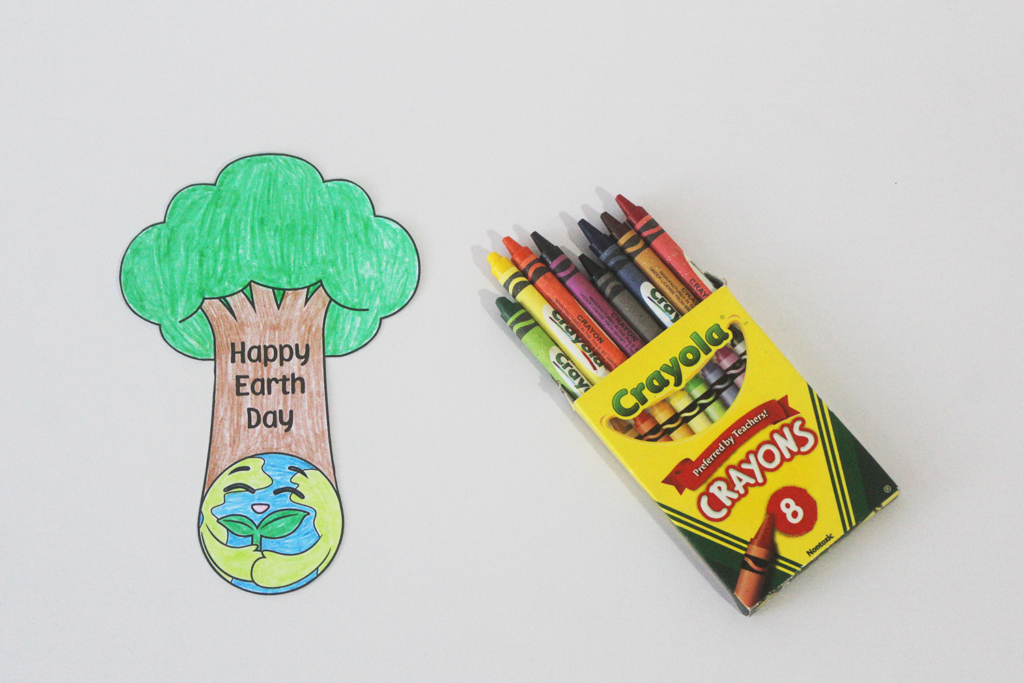
Book Pairing
Once you’re done making your bookmarks, be sure to share a good book so your child can put them to use! We recommend pairing this DIY Earth Day bookmark activity with books that talk about nature and Mother Earth to help kids learn to appreciate our planet and the importance of caring for it.
Tip: For added environmental impact, look for these books at your local library or used bookstore, and explain to your child the power of reusing and recycling materials.
My Friend Earth by Patricia MacLachlan is a lovely picture book that discusses the wonderful things our planet does for us. The book has amazing kid-friendly illustrations and interactive die-cut pages that encourage exploration.
If You Come to Earth by Sophie Blackall, a two-time Caldecott winner, is an engaging story book that conveys a valuable message about the need to take care of our planet and of each other.
Another good book for young kids is The Earth Book by Todd Parr, which includes easy and smart ideas of how we can help each other to help the Earth. It also shares handy tips for kids to do their part for the environment and “go green” everyday.
Want to make more bookmarks? Try our other easy make-your-own-bookmark tutorials: You’ll learn to make a cute DIY cat bookmark, DIY fruit-slice corner bookmark, DIY chunky tassel bookmark, DIY elastic bookmark, and DIY cut-out-shape bookmark. Or get access to all of our printable bookmarks when you sign up for our free VIP (Very Intentional Parent) Vault of resources.
MayaSmart.com is your one-stop-shop for raising a reader, from evidence-based advice (like answers to parents’ top questions about teaching kids their ABCs) to fun activities that support key literacy learning and recommendations of great reads. Browse around the site for more tips and tutorials, or message Maya with your questions or activity requests!
I had the pleasure of chatting with Steve “Homer” True about my forthcoming book Reading for Our Lives: A Literacy Action Plan from Birth to Six, during the March 3 episode of the Marquette Basketball Hour on ESPN Milwaukee 94.5. You can listen to the interview on Apple Podcasts to hear my thoughts on the most important things parents and community members can do to support literacy.
I take the mic from my husband, Shaka, the Marquette men’s basketball coach, at the 28-minute mark and share how I got into early literacy, why I’m so passionate about it, and why writing the book was much, much harder than I expected. (Hint: It’s good news for readers.) Some highlights:
Homer: You’ve written a book … [Tell] us how this became so important to you.
Maya: This has really been a passion project for me for the last several years. It’s a guide and a handbook for parents to help them and support them as they raise readers.
It starts with birth, because all of the work that’s done to forge the brain architecture that supports later reading starts in infancy. And I think a lot of parents don’t realize that things they’re doing long before a child can talk really affect their language, learning, and literacy prospects down the road.
Homer: What made you come to this conclusion?
Maya: The seed of the idea for the book began just from being a mother and watching my own daughter’s journey to becoming a strong, fluent reader unfold. I’m named after a writer, Maya Angelou, and my husband and I named our daughter Zora after another writer, Zora Neale Hurston. Writing and reading have always been a huge part of our family spirit and family dynamic.
So, as she was becoming a reader, I just started asking questions and reading and learning more and more about that process. I discovered that many children didn’t have the opportunities that Zora had to thrive, because their parents didn’t know some of the things that they needed to teach them or help them with.
Homer: What's the most important thing parents could do or people should try to do to help families?
Maya: It would be helpful if everyone understood how important those early nurturing back-and-forth conversations are with babies. Long before they can respond with words, they can respond to you with coos and babbles. The eye contact, the gestures, and the listening— giving them a chance to respond, even when we can’t interpret what they’re saying—is really important, because that’s how the brain connections are formed that support reading.
Homer: How do you convince or get people to be different than they are or would appear to be, based on the research you've discovered?
Maya: I think a lot of it is information. I think most parents are motivated to set their kids up for success in life, but haven’t been told the specifics of how to do that from day one. … I think parents already have the desire. Another thing people can do in community groups, within their family, within their neighborhood, is give people the support to help them believe that they can do this and that they make a difference.
Homer: So, in elementary school, we have kids come early to provide them food, we need to have them come early to read or to interact. Does that make sense?
Maya: It does. I think another misconception that a lot of people have is that they can just bring their child to kindergarten, drop them off, and the school will take care of whatever shortcomings the child arrives with, but teachers are under a lot of pressure. And we also know with COVID, and all kinds of other dynamics within school, that it’s hard for teachers to specifically tailor their instructions to the needs of individual kids, in many cases.
So when kids arrive behind, they absolutely need additional support. And that can come through reading specialists in the school, it can come through volunteer tutors, it can come through library programs and all sorts of things. But we just need a critical mass of people understanding the ingredients that go into solid reading and helping more kids get those, get the practice, the reps in, as you would in basketball or a sport.
Homer: So is it good to have people just read to them?
Maya: Reading to kids is absolutely important. … Kids learn a lot from seeing you with the book and they learn the direction of the text on the page, if you point it out. But I emphasize the talk around the story. Not just reading it straight through, but pausing and telling them, “this is the title, this is the author,” and asking questions is really important when you go through a book.
But then there’s also a major, major role for just direct instruction in those foundational skills—so teaching kids the sounds of English, teaching them what letters look like. As adults, if we’re all fluent readers, we have no memory of what it’s like when you don’t know the difference between a letter or a number, or just a drawing on a sheet of paper. Little kids have to learn all of those things, and our talk when we bring their attention to print really helps support that.
Homer: All right, [kids have] got phones. We’ll have them use that phone to do all the things you just said they need to do. Is there any legitimacy to that theory, even though phones are always viewed as bad? I've always thought kids can literally learn everything on their phone. Is that a problem rather than a benefit?
Maya: I think there is, and always will be, a strong role to play in the one-on-one, back-and-forth dialogue and exchange between real people in real time. So there’s a role for devices at some point when kids are older, but in the beginning, they just need you, they need your attention. They need your love. They need your gestures, your words.
My goal isn’t to publish the book. My goal is for a parent to feel confident that they can support their child in reading.
Maya Smart
Homer: Which means it's going to be tougher, because that's an easy alternative that didn't exist before, right?
Maya: And the other thing about technology is sometimes it takes the parents’ attention away. So sometimes we have to be intentional about putting our devices down, so that we can give kids the language nutrition and experiences that they need to learn and grow.
Homer: Has there ever been such a book or an approach taken by others?
Maya: There are books that emphasize different points that are within my book. What makes my book unique is that it shows parents how the whole path unfolds, from when you bring that newborn home all the way to the point when they are in school and are getting explicit reading instruction. I think parents need that big picture of how this thing that you’re doing with your two-year-old affects their IQ in middle school. So it tries to connect those dots, to give parents that big-picture perspective. And then it also teaches parents how to teach specific skills, beyond reading to kids.
Homer: Parents are going to go, all right, Maya, what's the most important thing I have to do? What's number one?
Maya: Number one is that closeness of holding that newborn baby, when you bring them home, and beginning to talk to them from day one to build those language skills. I use the acronym TALK: Take turns. Remember that it’s a conversation—even with a baby that can’t yet say mom, dad, or any other words, it’s still a conversation—so listen for those coos and babbles.
The A is ask questions, because in those pauses, after we’ve asked a child of any age something, their little brain is at work, trying to respond and answer, and that’s how they grow and learn. So T taking turns, A is asking questions, L is labeling and pointing. So “this is the table,” [as you’re] pointing to it. So their eye has joint attention with yours and they learn the words that go with the objects in their immediate environment or on the page in the book. And then K is keep the conversation going.
It really is about that kind of back-and-forth, that ping pong, that extra pass, when you’re talking to a child—always try to get that extra exchange in the conversation.
Homer: When does reading start?
Maya: I think it starts from day one. That’s something that’s different about my raise-a- reader book, that it doesn’t start with teaching the alphabet song or even reading a book, although those things are important. It really is about how you forge the brain architecture that supports reading down the road.
Homer: And lastly, writing a book—is it as hard as you thought? Not as hard?
Maya: Much, much harder than I expected. I really wanted it to be a guide that is informed by actual research, so that the recommendations that I give are all based in evidence. I interviewed a ton of reading researchers and brain scientists and psychologists and all of these people to get their best recommendations, as opposed to just spouting my opinions about these topics.
But then after I had all of the scientific information and reading all these studies, I had to translate it in a simple way that people can remember and implement, because my goal isn’t to publish the book. My goal is for a parent to feel confident that they can support their child in reading. And then when that child gets to school, that parent can become an advocate for all kids, because they’ll know what it takes to do reading instruction.
By Susan Gadamus
Books about birds and nature introduce children to a whole new vocabulary and encourage observation and focus. And when you pair nature books with a walk outside, you open the door to conversations that will further enhance a child’s understanding, paving the way to eventual reading.
It doesn’t matter if you have a baby just starting to babble or an older child with a strong vocabulary. Reading and exploring together keeps the adventure going and the language flowing.
A simple walk around the block becomes a bird walk when you observe a pigeon fly by or notice a starling nesting in a streetlight. In this post, we’ll talk about how to introduce your little one to bird-watching, share a simple craft to make DIY “binoculars” that will promote focus, and give recommendations of books that will get your child excited to observe your feathered neighbors.
How to Take a Bird Walk with a Toddler or Preschooler
As you head out the door with your child, prepare them for what they might see on your bird walk. First, tell them that you’re going to look for birds. Share that you could see birds in the sky, in trees, or perching on telephone wires. Explain that you may need to be quiet or keep your distance to avoid scaring them.
To encourage observation—the first step in the scientific method—tell your child that you’re going to count all the birds you see. With an older child, say you’ll observe what the birds are doing. Are they eating, traveling, resting, or something else? Share that scientists study birds and their activities to help protect them and the places they live. You can even bring along a little notebook to note any birds you see or details about your observations. If your child is interested, they could try drawing a picture of what they see. Your focus should be on deeply engaging your child with the world.
If you have a baby or young toddler learning their words, simply describe to them the nature you see and react to their contributions, whether it’s vocalizations, pointing, or just looking in a certain direction. Responding seriously to their early attempts at communication paves the way for future literacy. On your walk, point to the birds you see and describe them: the duck is swimming in the water, a white bird flew over our heads. It’s ok to talk out loud to your baby and early talker in public; all parents do it!
Tip: If birds are hard to find, expand your gaze to include plants and find some flowers growing near the sidewalk. For those who can’t venture outside, putting up a bird feeder in your backyard or on your balcony allows your child to observe birds closer to home. When we lived in Alaska, my young toddler loved going on walks year-round to see birds and touch plants. But on days when it was too cold to venture outside, she still enjoyed watching the chickadees and squirrels at our backyard feeders.
Bird Walks Are Fun … and Build Your Child’s Brain
As children learn to talk, they build a foundation for reading and writing. When parents and caregivers talk and respond to children, they provide them with a bigger and more diverse vocabulary. This vocabulary gives these kids a leg up when they are later learning to read.
Another great thing about a bird walk is that many of the words you’ll use start with sounds that are easy to hear and say. The letter B for bird, the letter D for duck, the letter G for goose; these are all sounds that babies and toddlers find easy to mimic. And don’t worry if your child isn’t much of a talker. When my daughter was 17 months old, she wasn’t talking much yet, but she understood so much of what I said. As I told her the names for things and described what we saw on a bird walk, she was absorbing all those words for future talking and reading.
Making a pair of binoculars out of toilet paper rolls can also help older kids engage in the discussion. Follow the steps below, and encourage them to practice using the binoculars as you read a book together—see suggestions for some stellar picture books below. Then you’re ready to set out on your bird walk!
Bird Walk Craft: DIY “Binoculars”
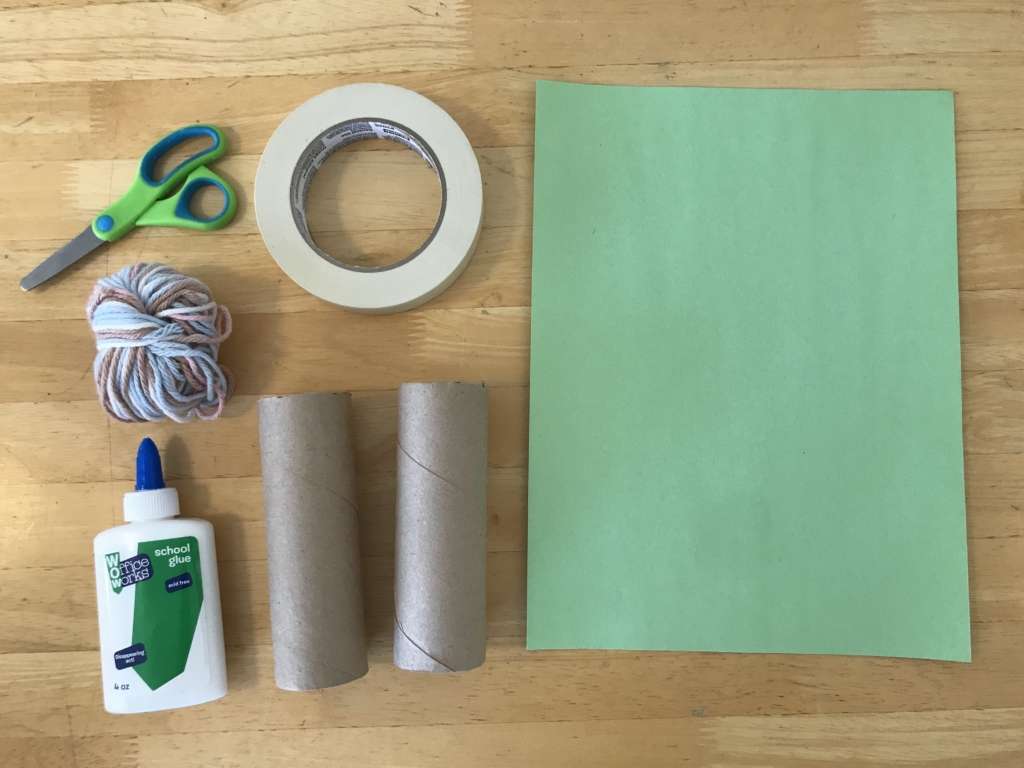
Materials (makes one pair of binoculars)
- Two toilet paper tubes, or one paper towel tube cut into equal halves
- Masking tape or white glue
- Scissors
- Yarn, string, or adult shoelace
- Construction paper, pens, glitter, tissue paper (optional)
- Hole punch (optional)
Step 1: Position two toilet paper tubes side by side and tape and/or glue them together along the long edge. If you use glue, continue to the next step while the glue dries.
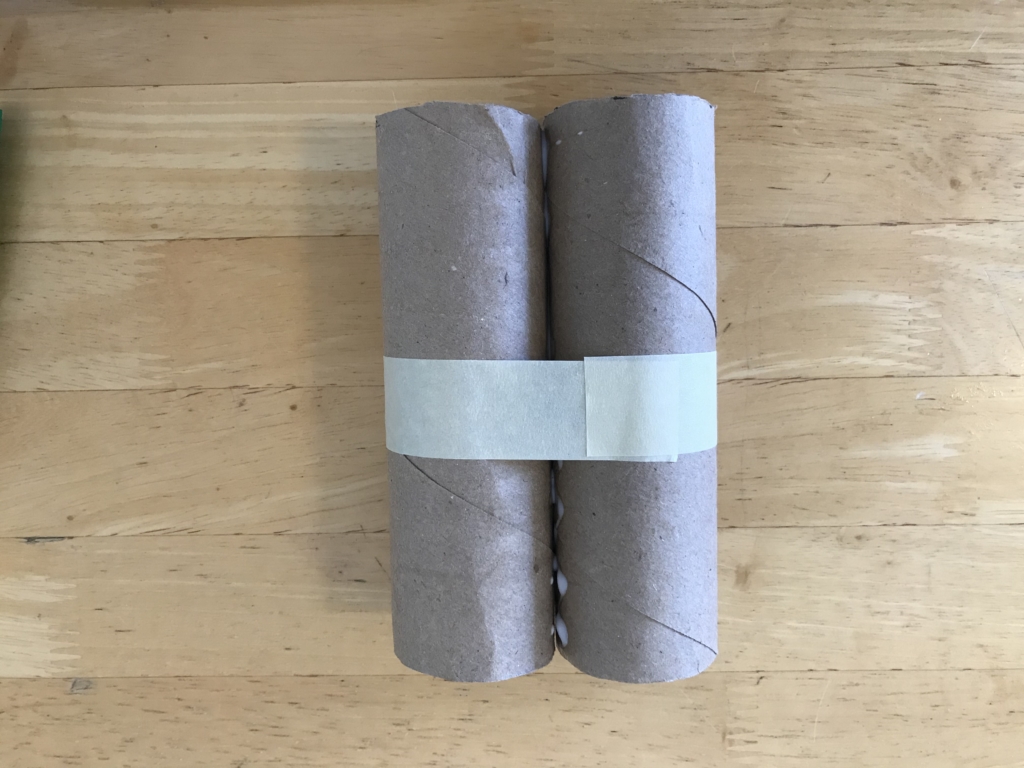
Step 2 (optional): The next two steps are optional, but add fun and decoration. Cut a standard-sized piece of construction paper roughly in half the long way, about the width of the paper tubes. Then decorate it using pens, glitter, tissue paper, or whatever! Just avoid materials that are heavy or very wet. Wrap the decorated paper around the binoculars and attach the edges using tape or glue.
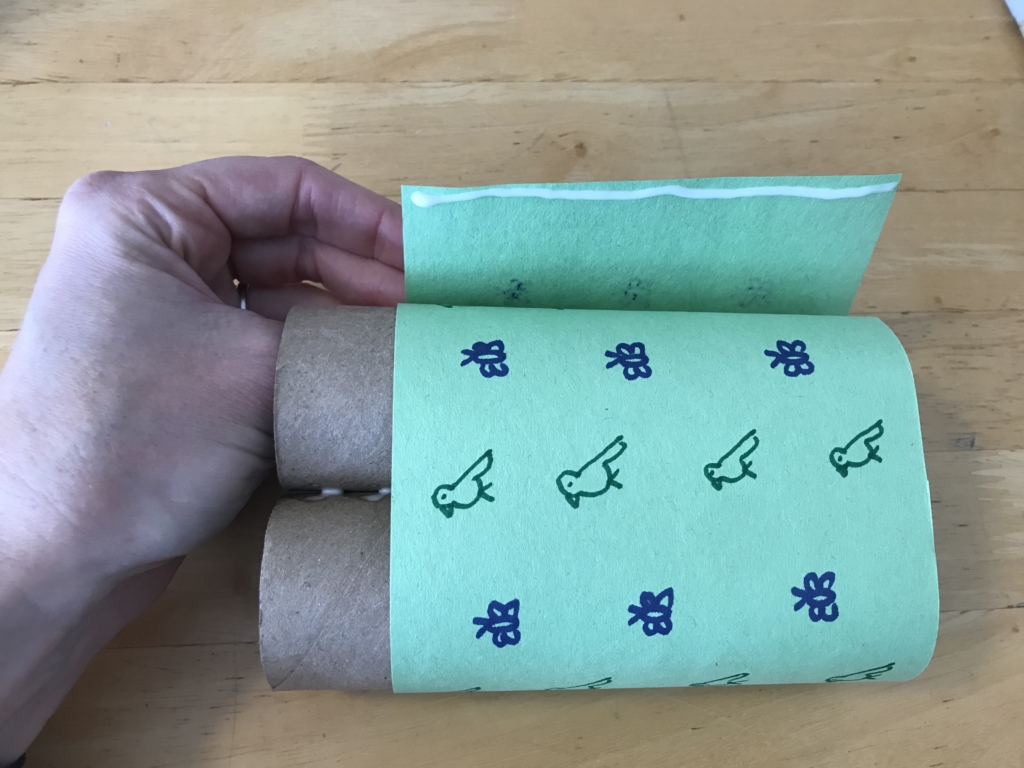
Step 3: When all glue has dried, punch a hole on the outer edge of each paper tube, or carefully use scissors to make holes. Then thread your string or shoelace into each hole and tie off each side. The binoculars should fall to your child’s chest, and be easy to take on and off. (For young children who may have trouble with the string, you can skip this step.)
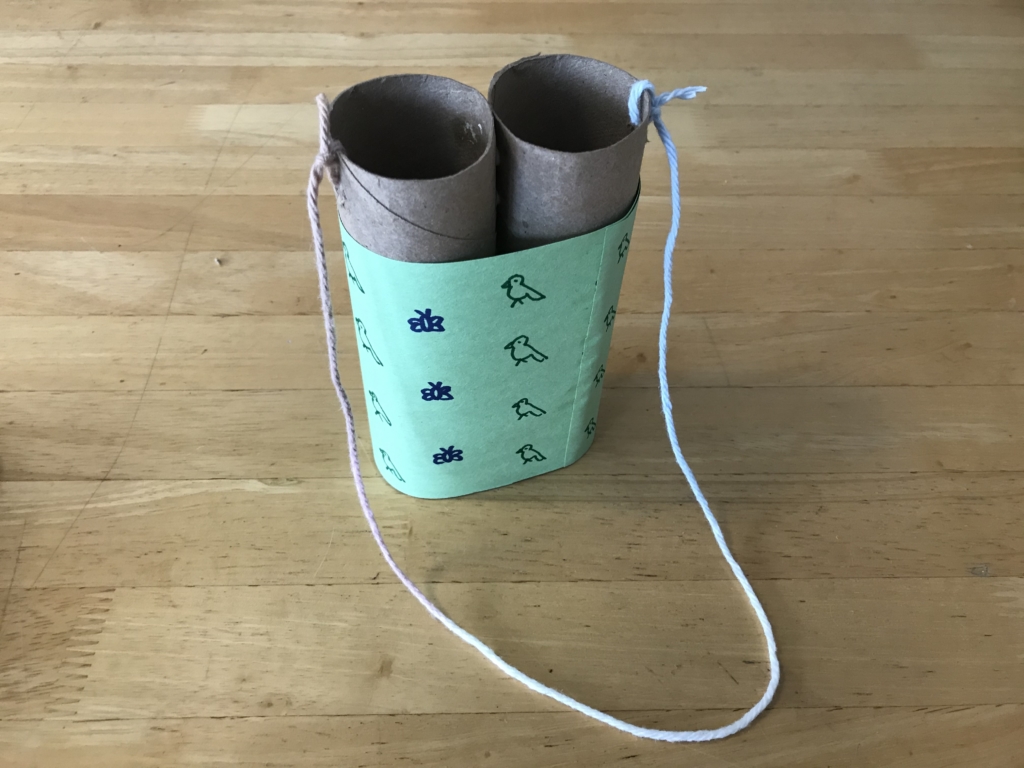
Parents, don’t forget to make a pair for yourself so you can demonstrate and join in the fun. Now that you’ve got the gear, you’re ready to use the binoculars to encourage focus during your bird walk and story time. While reading, help your child use the binoculars to look closely at the pictures. Inside and out, ask questions about what they see, and be sure to pay attention to where they choose to point their binoculars. Following their gaze is a great way to respond to their interests.
Picture Books About Birds & Nature
Before you start out, get excited for birds and nature with one of these books. Then, revisit the stories as you walk. After you get back, read them again or let your child page through them on their own as they connect the stories to their own memories.
Bird Count by Susan Edwards Richmond follows a girl and her mother as they become scientists for a day and participate in their community’s annual bird count. This enjoyable story also encourages close observation, counting, and taking notes. If your child enjoys this book, consider reaching out to a local birdwatching group to learn more about bird walks and counts in your community.
Ranger Hamza’s new book, Let’s Go For a Walk, is designed to take with you on an outing! This adventure manual is jam-packed with nature observation, questions, and science facts. Choose a couple of the pages to read before you go, or just set up shop in the park to read and discover the wild world around you.
Have You Heard the Nesting Bird? by Rita Gray focuses on a quiet robin amidst her noisy bird neighbors. Even very young babies and toddlers will enjoy the pictures and their parents’ attempts to mimic the bird calls. (Noise books are great for engaging babies in books.) Older kids will learn the value of noticing the quiet things in a noisy world.
Phyllis Limbacher Tildes’s book, Baby’s First Book of Birds and Colors, will appeal to babies and toddlers learning their colors. Pointing out the birds and flowers in this book is the perfect prelude to looking for birds and plants on a walk (or window watch).
Reading the book Beautiful Blackbird by Ashley Bryan is a wonderful way to celebrate the beauty of all colors with your child. This warm and welcoming story is strikingly illustrated with lyrical text that is a joy to read aloud.
*Photos by Susan Gadamus
Like this post? Share it!
As a parent, the time you spend with your child—reading aloud, chatting, and interacting in countless ways—is pivotal in helping them develop and thrive as a reader, writer, and thinker. From teaching your child the alphabet to playing rhyming games, you instill crucial knowledge and skills through fun, playful time together. Best of all, it builds your relationship, too—and can even help you feel happier and more fulfilled.
That’s why each month we share a special list of featured reads and literacy activities. Expect fun seasonal reading recommendations, complemented with activity tutorials and free printables for an all-out story time experience with your little one.
Kids’ Books for Women’s History Month
March is Women’s History Month! It’s a good moment to highlight and celebrate the groundbreaking contributions women have made to our world. From blazing new trails in meaningful fields to embarking on monumental careers as inventors, authors, athletes, and so much more, women have made a tremendous impact in society.
It’s never too early to learn about how women have shaped the course of history. If you’re looking for some empowering books to enjoy with your child for Women’s History Month, check out contributor Karen Williams’s picks for inspiring picture books by and about a diverse set of amazing women. You also won’t want to miss early-childhood-educator Chrysta Naron’s piece on 11 fabulous female authors for your child’s bookshelf.
Ramadan Picture Books
Ramadan is one of the most important times of year for Muslims, a holy month of fasting, prayer, and introspection that’s meant to help believers strengthen their faith, self-control, gratitude, and compassion for the less fortunate. As contributor and early-childhood-educator Carlene Murray writes, children are exempt from fasting, but they can engage in introspection and cultivate these same qualities through thoughtful shared reading, including sharing Ramadan books for kids.
Murray offers a selection of children’s books about Ramadan to share with your little ones, whether to teach them about their own cultural and religious heritage or to introduce them to another tradition. Note that Ramadan is celebrated in the ninth month of the Islamic year, which is slightly shorter than our Western calendar, meaning it happens at a different time each year.
March Madness Basketball + Baseball Picture Books
Plaaaaay ball!
It’s March Madness and baseball season… and that’s one more reason to pick up some new picture books.
Sports picture books can be a great way to engage little fans in reading, plus impart life lessons about teamwork, discipline, perseverance, and resilience. What’s more, there are some wonderful sports stories that are just right to spark important conversations about history, racism, progress, and values.
Check out Courtney Runn and Chrysta Naron’s thoughtful roundups of awesome baseball picture books, basketball picture books, and kids’ books for March Madness to find curated titles.
Books for Surviving Spring Break
If you have kids in school, spring break is a challenge and an opportunity. It’s a challenge to keep your little ones happily employed while school is closed, and it’s an opportunity to get in some bonding time, educational experiences, and even travel if you’re able. And some great reads will help with both aspects!
To engage, educate, and entertain your kids during their break, browse our many themed lists of books for kids, our roundups of audiobooks for toddlers and audiobooks for preschoolers, and our article about using books to prepare young children for successful visits with extended family.
Story Time Activity: Literacy Soccer
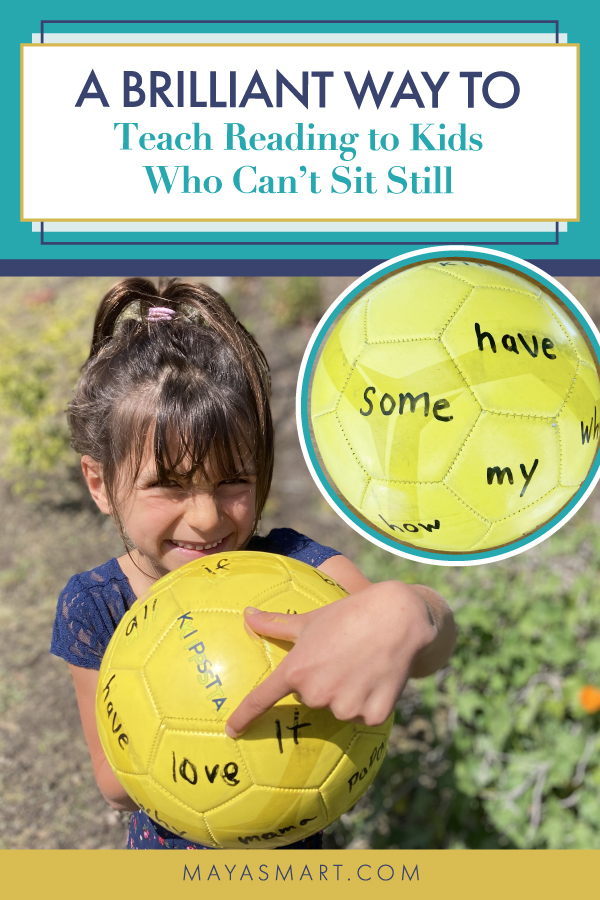
Kid can’t sit still? Don’t make them! With the weather getting warmer, you can practice reading or pre-reading skills while you toss or kick a ball around together outside. Just find an old soccer or playground ball, grab a sharpie, and follow these tips to teach your child to read with a DIY soccer game.
We’ll be back next month with our guide for what to read to your child in April. Meanwhile, go ahead and browse around the site for more tips and tutorials. We’re so happy to have you here!
Enjoy this post? Please share it on social media.
New to MayaSmart.com?
Welcome! It’s lovely to have you here. I’m Maya, an author, literacy advocate, and mom. On this site, I publish articles, advice, book recommendations, and activities for busy parents. Through it all, my goal is to help parents like you feel equipped and confident to support your children in reading. Let’s start by understanding what you bring to the effort—your unique superpower.
Find your raise-a-reader superpower now.
